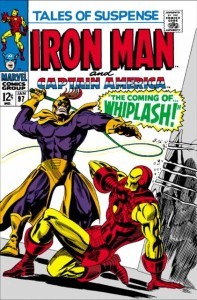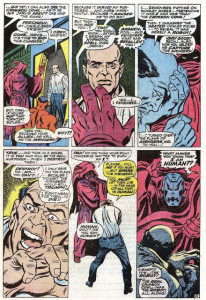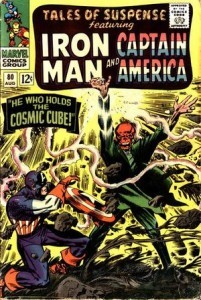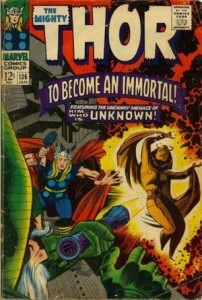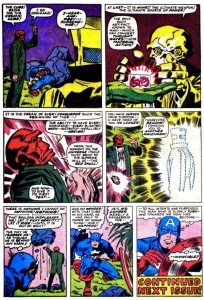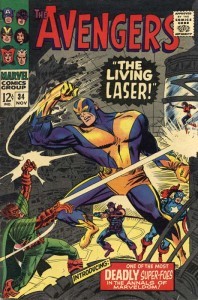Daniel Sherrier's Blog, page 43
April 6, 2016
Free days ahead for Earths in Space: We Must Evolve!
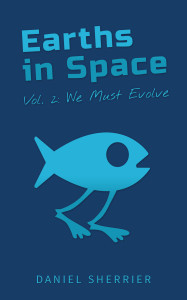 Get your Kindles ready. The Earths in Space vol. 2: We Must Evolve e-book will be free on Amazon for the first time ever from April 7 through April 10.
Get your Kindles ready. The Earths in Space vol. 2: We Must Evolve e-book will be free on Amazon for the first time ever from April 7 through April 10.
In case you missed it, here’s the back-cover blurb:
Life can evolve. Amena saw the evidence on an ancient Earth. It wasn’t pleasant evidence, and it wasn’t evolution into sentient life, but she saw evidence.
So okay, she accepts that no little green men exist on alien worlds, but maybe one of these other Earths holds evolved humanity.
Evolution faces a powerful obstacle, however — humanity itself.
Volume 2: We Must Evolve begins with the discovery of a mysterious ark full of refugees caught in orbit over Pluto…
Wait, an ark full of refugees…?
Well, that’s one Earth that’s not evolving. But another could be doing better. It’s possible, Amena keeps telling herself…
Continuing the action-packed Earths in Space series, We Must Evolve features a novel-length journey told in four novellas — “The Pluto Factor,” “Worlds to Save,” “The New World,” and “On Hold.”
If you’ve never read the first Earths in Space … well, I’m just sorely disappointed in you. But being the forgiving soul that I am, I’ve structured the sequel so it can stand on its own even as it builds upon previous events.
So, starting bright and early April 7, indulge in some free reading, why don’t you?
Have fun.
March 17, 2016
Avenging The Fantastic, Part 11: Behold … The Vision!
Continuing the read-through of as many Avengers and Fantastic Four–related Marvel comics as possible!
Books Read
Captain America #106-113; Iron Man #5-14; Avengers #57-63; Fantastic Four #80-81, Annual #6; Captain Marvel #6-14; Incredible Hulk #104-115, Annual #1; years: 1968-69.
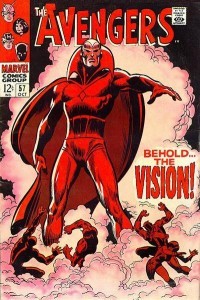 The Revolving Door of Avengers Mansion
The Revolving Door of Avengers Mansion
The Vision joins! More on that below.
Otherwise, the membership stays relatively stable in this set, aside from a couple of identity adjustments. Hank Pym, already on his third superhero persona in less than a decade of stories, switches out his Goliath identity for a fourth persona, Yellowjacket. Maybe this one will stick for a few weeks. Meanwhile, Hawkeye realizes the flaw in being an archer superhero—if your bowstring breaks, you’re kind of useless—so he uses Pym’s growth serum to become the new Goliath.
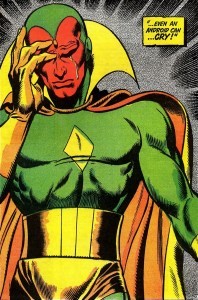 The Best of This Bunch – Avengers #57-58
The Best of This Bunch – Avengers #57-58
As the Vision arrives, The Avengers finally starts getting good. The Vision is the team’s first recruit who didn’t first appear in another book…unless you count Wonder Man’s one-issue stint way back in #9. Artist John Buscema creates a memorable appearance and suitably moody atmosphere while writer Roy Thomas crafts a compelling backstory that gives the Avengers their very own family tree of sorts.
The Vision is what they call a synthezoid, a being who is basically human-like but composed of synthetic parts. He was created by Ultron to attack the Avengers, and Ultron was created by Hank Pym, because what biochemist doesn’t dabble in robotics? (Scientists don’t specialize in the Marvel Universe—they all know all the science.) Ultron implanted the brainwave patterns of the late Wonder Man into the Vision’s artificial mind. Those brainwaves were conveniently lying around because the original Avengers decided to record the dying man’s brains way back when…because that’s a thing you do? Sure.
So, for those keeping score, Pym is the “father” of Ultron, who Oedipally wants to kill him. Ultron created his own “son” in the Vision. The Wasp, as Pym’s girlfriend, winds up as the mother figure here. Wonder Man, who will be back again someday, is sort of the Vision’s “brother.” This tree shall grow as time goes on.
In the Avengers: Age of Ultron film, however, Tony Stark and Bruce Banner create Ultron and the Vision. That makes more sense. On the other hand, creating Ultron is the most interesting thing comic book Hank Pym has done so far, and as we’ll see, the guilt will give him some internal conflict (too much, actually).
While we’re on the subject of familial relations…
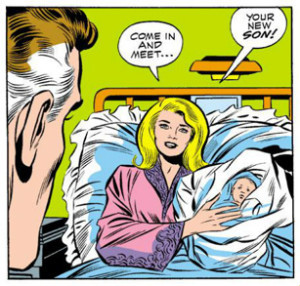 The Richards Baby Is Born – Fantastic Four Annual #6
The Richards Baby Is Born – Fantastic Four Annual #6
Reed and Susan Richards are officially parents as of this issue. The Invisible Girl gives birth to their son, Franklin, though she’s (ahem!) invisible for most of the story. Since delivering a baby and sitting around a hospital waiting room hardly makes for a compelling comic, the bulk of the issue follows Reed, Johnny, and Ben as they travel to the Negative Zone. Sue’s irradiated blood is endangering her son’s life as well as her own, and Reed suspects a cure can be found in this other dimension.
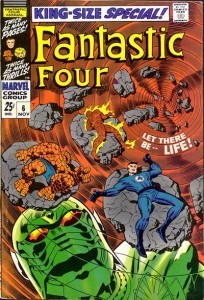 Sue’s condition becomes national news, because the FF are the celebrity superheroes of the Marvel Universe. The hospital even holds a press conference: “Dr. Molinari, would you explain the matter of Mrs. Richards’ blood cells, please?” says a hospital official, patient confidentiality be damned.
Sue’s condition becomes national news, because the FF are the celebrity superheroes of the Marvel Universe. The hospital even holds a press conference: “Dr. Molinari, would you explain the matter of Mrs. Richards’ blood cells, please?” says a hospital official, patient confidentiality be damned.
The Fantastic, er, Three meet a new villain in the Negative Zone, one who will return many times to haunt them—Annhilus. Stan Lee and Jack Kirby have the whole “fun, imaginative, action-packed adventure” thing down to a science by this point. It’s no longer fresh, but they nail the formula.
The unfortunate and unavoidable side-effect of this pregnancy storyline is that it sidelines the Invisible Girl for a while. In the meantime, the Human Torch’s girlfriend, Crystal of the Inhumans, joins the team in #81, keeping the membership at the title-mandated four.
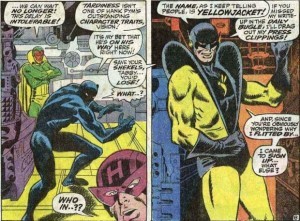 This Is Just Messed Up – Avengers #59-60
This Is Just Messed Up – Avengers #59-60
Hank Pym and Janet Van Dyne have a really unhealthy relationship. A lab accident causes Goliath’s mind to splinter and create a new identity—Yellowjacket. And as Yellowjacket, he believes Pym/Goliath to be a separate person whom he killed.
So when Yellowjacket confronts the Avengers, brags about killing Pym, and kidnaps the Wasp…how does the Wasp react?
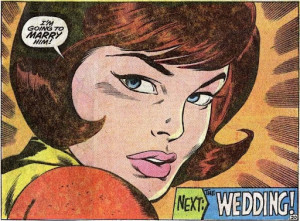 She decides to marry him. And they actually do get married while Pym is in this delusional Yellowjacket state. He snaps out of it following a kerfuffle with the Ringmaster and his circus gang, but still…Jan basically tricks Hank into marrying her while he’s suffering from a serious psychological condition.
She decides to marry him. And they actually do get married while Pym is in this delusional Yellowjacket state. He snaps out of it following a kerfuffle with the Ringmaster and his circus gang, but still…Jan basically tricks Hank into marrying her while he’s suffering from a serious psychological condition.
Yeah, this marriage will work out great.
As insane as the plot points are, these two issues are entertaining. But they are insane.
And Jan apparently has no friends who aren’t superheroes. The Invisible Girl is her matron of honor, even though we’ve hardly seen them together. Must be a mostly off-panel friendship.
After the honeymoon, Pym decides to stick to his psychosis-created Yellowjacket identity. What else would you have the man do? Something healthy? Perish the thought.
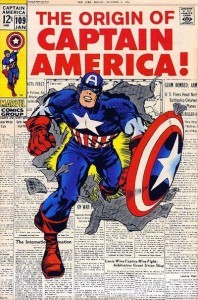 Let’s Do the Origin Again – Captain America #109
Let’s Do the Origin Again – Captain America #109
Captain America #109 retells his origin, which is pretty closely followed in the beginning of the first Cap movie (though the film gives it more room to breathe).
Among the main differences, however, is Bucky Barnes. Movie Bucky is Steve Rogers’ childhood best friend who was always looking out for him. Comics Bucky is an orphaned teenager who gets “adopted” by the same base Private Rogers is stationed at.
And this brings us to the secondary difference. Comics Cap had a secret identity during World War II, so Steve Rogers pretended to be a bumbling private and constantly drove his sergeant crazy. (Why this was necessary remains unclear.) But Bucky barges into Steve’s tent while he’s changing into Captain America, and the kid insists on becoming his partner. Cap responds, “I guess I have no choice!” Because of course a grown man (extra grown, thanks to science) can’t just tell a kid, Um, no, that’s absurdly dangerous, and my secret identity is not worth your safety.
So Bucky Barnes becomes…Bucky Barnes in a mask. (Guess he didn’t need a secret identity? Then why the mask…?) And he eventually dies because he’s an ordinary teenager trying to keep up with Captain America.
This continuity gets cleaned up decades later so it actually makes sense—comic book sense, anyway.
By the way, in #110, Rick Jones, friend of the Hulk and former Avengers tagalong, dons Bucky’s old costume to become Cap’s new partner. In hindsight, knowing the details about Bucky’s background that are revealed much later, it’s really cruel of Cap to lead an ordinary, barely trained teenager to believe he has a shot at filling Bucky’s shoes. But only in hindsight. Bucky was an entirely different character back then as far as Stan Lee and company were concerned.
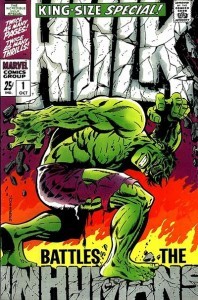 Hulk Smashes Inhumans – Incredible Hulk Annual #1
Hulk Smashes Inhumans – Incredible Hulk Annual #1
We learn who’s powerful enough to subdue the Hulk with one word—Black Bolt, the leader of the Inhumans. This oversized annual is better than most of the recent Hulk stories, and bringing Hulk to the Inhumans’ city makes for a nice change of pace…until the book falls into the usual patterns of people trying to manipulate the Hulk to suit their own agendas.
Still, it has a nice touch at the end—Black Bolt demonstrates kindness to the Hulk by inviting him to stay with the Inhumans…but Hulk, knowing the others would never accept him, rejects the offer and leaves. But he leaves with a smidgen of hope that maybe the world has more people like Black Bolt who could accept him as a true friend.
Captain Couldn’t-Be-Less-Fantastic – Captain Marvel #6-14
Captain Marvel gets boring pretty fast. Its main appeal to modern readers is seeing today’s Captain Marvel, Carol Danvers, in her formative stage.
Here’s the quality of hero we’re dealing with here:
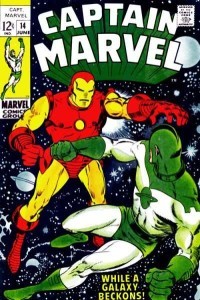 Captain Marvel, in #8: “At last, I shall inquire into the former life of Dr. Walter Lawson—whose identity I have stolen—if one can steal anything from a dead man!” …Yes? Yes you can. Ever hear of heirs?
Captain Marvel, in #8: “At last, I shall inquire into the former life of Dr. Walter Lawson—whose identity I have stolen—if one can steal anything from a dead man!” …Yes? Yes you can. Ever hear of heirs?
So Carol is in love with this paragon of ethics while justifiably suspicious about his stolen alter ego. Captain Mar-Vell’s Kree girlfriend, Una, observes—and fears—this attraction from a spaceship. Always a soap opera in the Marvel Universe.
Here’s another example of the perfect gentleman Carol has fallen for: “She tripped—hit her head on that tree! But—her unconscious condition gives me a chance to prepare myself for action!” –Captain Marvel, #10.
Iron Man briefly meets his future teammate for the first time in #14…and he blasts her with his repulsor rays, knocking her unconscious (a frequent occurrence in Carol’s pre-super days, apparently). Yeah, he was being mind-controlled by the Puppet Master, but still…not the best first impression a guy could make. But Carol’s bar seems to be pretty low at this point.
Meanwhile…
–Hey, Cap, if your psychiatrist is named “Dr. Faustus,” that might be a clue he’s evil. Though maybe Captain America doesn’t read classic British drama? (Captain America #106)
–“What’s that rovin’, red-skinned mass of muscle up to now?” –Johnny Storm, referring to his Native American friend Wyatt Wingfoot in cringeworthy fashion in Fantastic Four #80. Later in the issue, Johnny says, “But I’ll haveta leave Crystal! She’s gotta stay, in case Sue needs her!” Very good, Johnny—declare that your girlfriend needs to sit out on the upcoming adventure because she needs to watch over your pregnant sister, while not even your brother-in-law does any such thing, and don’t even ask the girl what she wants to do. At least Johnny has the excuse of being an inexperienced teenager, unlike the hopeless case that is Reed Richards.
And still later in the issue: “Flaming fireballs!” Are there any other?
FF #80 is justifiably not a classic.
–“Seems strange there hasn’t been some response from Janice Cord to the flowers I’ve been sending…” –Tony Stark, genius, in Iron Man #6, referring to the young woman whose father recently died as a result of the man’s obsessive hatred of Tony Stark.
–Whitney Frost begins doubting her position as head of the Maggia because she’s falling in love with SHIELD Agent Jasper Sitwell (who, to his credit, realizes she’s been using him for info). We also learn that Whitney is the daughter of the villainous Count Nefaria. And in Janice Cord, Iron Man falls for another woman who thinks Tony Stark is a coward—it’s like Pepper Potts all over again.
–Hulk, Incredible Hulk #113: “Betty Brant is there! She might be hurt!” Silly Hulk (and Stan Lee). Perhaps you mean Betty Ross and not Peter Parker’s first girlfriend?
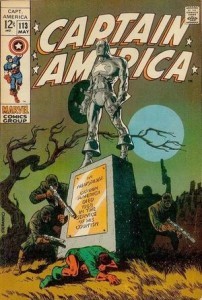 —Incredible Hulk #115 has an interesting premise—the villainous Leader offers his aid to the U.S. Army to trap the Hulk…and he succeeds. But sometimes the enemy of your enemy is another enemy…and a greater threat.
—Incredible Hulk #115 has an interesting premise—the villainous Leader offers his aid to the U.S. Army to trap the Hulk…and he succeeds. But sometimes the enemy of your enemy is another enemy…and a greater threat.
–In Captain America #111-113, Cap fakes his own death to make his identity secret again. Would’ve been much easier to maybe not tell anyone in the first place, but okay. That’s what your rash decisions will get you, Cap.
–“The proud Wakanda do, indeed, dwell within a man-made jungle! No man—white or black—gains admittance to our land unless we desire it!” –Black Panther, Avengers #62. Well, at least he’s egalitarian with his border enforcement.
To Be Continued…
Coming up…Thor meets Galactus!
March 6, 2016
A ‘Terrific’ Prologue
Prologues are tricky. They must abide by a certain set of rules: be concise, don’t drown the reader in tedious information, make sure something happens, and adopt a viewpoint other than your protagonist’s. Basically, a prologue must act like the teaser before a television show’s opening credits.
I wasn’t originally planning on using a prologue in Terrific, my upcoming novel featuring the world’s greatest superhero — Mighty Woman! But then I realized it could provide an effective way of introducing the villain and laying the foundation for her arc.
The results are below. It’s still rough, unedited, and very much a work in progress, and you may well spot a typo or five. But it is evidence that, yes, I do remain hard at work on this thing. Plus, I feel like sharing something. So here we go…
*****
Copyright 2016 Daniel R. Sherrier
Terrific
Prologue
Doctor Death Junior was a cackler. This child who had barely entered her teens deigned herself worthy of succeeding the greatest genius who ever lived. Dumb luck alone granted her the opportunity.
Graffiti was her hobby, and a police officer had caught her in the act of “painting” beneath a highway bridge. While eluding arrest, she stumbled upon Doctor Death’s subterranean lair, where an unavoidable lack of maintenance had degraded the security system, granting the juvenile delinquent access to the arsenal of a superior intellect. But acquiring his tools did not mean she acquired a sufficient understanding of his mission. Therefore, Doctor Death Junior became one of the ridiculous ones, yet another narcissistic super-villain who wreaked pointless havoc for no grander purpose than her own inane entertainment. She purloined the infamous name of Doctor Death for escapist fantasy.
Clarissa needed to kill the pretender. Her father would have wanted it that way.
She had wanted to deal with her sooner, but her father withheld the location of his lair until her eighteenth birthday. Finish your education first, he had insisted. As if any school system had much to offer her anymore. The unfortunate delay allowed the embarrassment of “Junior” to persist far too long. But at last, Clarissa was ready to end this fraud.
Her father provided hints about how to craft a failsafe mechanism in the event his suit of armor fell into the wrong hands. Clarissa was tasked with filling in the gaps to complete the device. He had trusted she was up to the challenge, and she rewarded his confidence by accomplishing the objective. She required no dumb luck to achieve her victories.
Junior was hardly the brightest prey. After stealing someone’s identity, returning to that someone’s lair on a continual basis was a foolhardy habit. Apparently, Clarissa needn’t have bothered concocting a tracker.
Clarissa descended below ground and marched toward the lair’s secret entrance. For this task, she donned no costume nor took any measures to conceal her identity. What did it matter? The girl would be dead within the next few minutes.
The idiot had neglected to reactivate the security system—likely had no clue it existed in the first place—so Clarissa strode down a tunnel that led directly into the main room. Incessant cackling assaulted her ears, growing louder with each step.
“Flee, mortals!”
Oh God. Junior was rehearsing.
“Flee before the awesome power of Doctor Death Junior! Ha ha ha!” And it didn’t even sound rehearsed. It merely sounded bad. “None can thwart my touch—my touch…of death!”
The gene pool would thank Clarissa for eliminating this strand.
This arrested-development imbecile didn’t even hear Clarissa enter, which afforded the latter a moment to inspect the lair’s condition. The place was so…sterile. No. Tainted.
The original Doctor Death had stored his many inventions and prototypes here, but several of those delicate machines, each beyond Junior’s comprehension, had been haphazardly shoved against one wall. The apparent purpose was to make space for a practice area so she could play with the armor’s various functions. Disrespectful. And she was lucky she hadn’t blown herself up.
Clarissa could take inventory later. For now, she simply needed to confirm that Junior was indeed wearing the armor and that spares remained. The wall compartment was carelessly left open, displaying five sets of Doctor Death’s lightweight, black-and-gold armor. As for Junior, the fool had her black cape turned to the entrance, and the matching helmet covered the back of her head. A flourish of her arms revealed flashes of gold, providing Clarissa with necessary confirmation.
Junior must have used the miniaturization circuits to compress the armor so it would fit her much smaller frame—circuits the original Doctor Death had employed for stealth entrances and last-minute escapes, not banal tailoring.
“No, too high,” Junior muttered to herself before trying again. The display was pitiful. “None can thwart the touch of Death! Ha ha ha!”
Clarissa’s skin jumped in revolt. If only Junior had channeled this much effort into learning about the scientific achievements that surrounded her, she might have been a halfway-worthy successor…at best.
Extracting a small remote control from her jacket pocket, Clarissa pressed a button. Her sole regret was that she couldn’t see Junior’s face as the armor’s joints locked into place. But at least the cackling ceased.
Clarissa allowed the pretender to wriggle in confusion for several seconds, her every effort futile—not that she seemed to grasp the futility.
“Who dares to enter this place?”
“Face me,” Clarissa said, dialing a sequence on the remote.
Against her will, Junior completed several clunky steps until she had turned half a revolution and saw a tall, lanky teenager with a pixie cut and penchant for dark clothing.
Clarissa maintained a stoic front, though she was taken aback at how young Junior appeared up close, even with a mask obscuring the top half of her face. The kid was only about four years younger, but they were four long, important years. Clarissa had been Junior’s age when she learned who her father was and began the interminable wait. But no way was she ever this young.
“Junior,” Clarissa greeted with a slight nod.
The pretender fidgeted, but her armor permitted no movement, not even the slightest twitch. “What did you do? Why can’t I move?”
“Because you don’t know the override code. If someone pulled this on me, I’d be free in an instant. Can you figure out why?”
“Don’t know and don’t care. I was in the middle of something, and you’ll pay when I—”
“Middle of embarrassing my father.”
“Your—?” Letting her act of defiance fall to the wayside, Junior’s face opened up, and her delighted squeal grated worse than the cackling. “You’re his daughter! Oh my God! Your dad is awesome! What’s he like in person?”
Clarissa wished she knew. “Do you even comprehend what his mission was all about? Do you understand why he undertook any of this?”
“Mission?”
Ugh. “He called himself a doctor for a reason. Doctor Death was trying to heal the world.” Clarissa had watched her father’s posthumously delivered recording numerous times, and she could recite his words nearly verbatim. “The way to do that is to attack its most persistent plague—mankind. This planet is overstuffed with people who should have been evolutionary dead-ends—who should never have achieved life in the first place—but all this human refuse manages to find each other and reproduce, creating even worse examples of humanity. Our species will soon grow too bloated and collapse under our own weight, taking the whole planet down with us. But my father wasn’t content to wait for disaster to happen. The Earth’s population needs to be drastically reduced so the remainder may flourish. That’s what he was working on…until Fantastic Man killed him.”
“No way! I knew it had to be something like that.” Junior seemed to have comprehended only the last part. Clarissa’s mistake—not taking the simple-mindedness of her audience into account. “So wait, who’s your mother? Is she a super-villain, too? Which one?”
Her mother died of cancer five years ago, after a too-long battle. She had been one of the world’s precious few innocents who never hurt anyone. She deserved the better life her ex-husband was striving for.
But Clarissa bit her tongue, looked down, and pressed buttons.
Junior’s arms lifted, and not by her own doing. Her hands stretched in opposite directions, and they kept pulling—not forceful enough to inflict lasting damage, but enough to hurt. The kid’s eyes moistened, and the crying followed even sooner than Clarissa had dreaded.
“I’ve been watching you,” Clarissa said. “Carrying on like a lunatic all these months as you pranced around trying convince the world you’re some ‘super-villain.’ Clearly, you fail to grasp the importance of the mission. You’ve been ruining my father’s name, so it’s past time we end the taint that is Doctor Death Junior.”
“Ow, ow, ow! Please! I’m sorry!”
“Do I look like I want an apology?” Clarissa increased the pressure.
Junior shouted, embarrassing herself with her sobs. “Don’t—I don’t want to die!”
But she needed to. Clarissa had several options for how to go about it, and she considered which would be most appropriate. Ripping her in half would have been needlessly gruesome, nor did she look forward to listening to Junior’s screams as the armor’s gauntlets turned their life-draining energy back onto her.
A more elegant solution sprang to mind. Clarissa activated one of the armor’s special features, one she assumed Junior was already familiar with.
A look of horror overcame the pretender as she slowly dwindled in size. Clarissa imagined it from Junior’s perspective—the true heir growing gigantic as she reclaimed the mantle that was rightfully hers. This was appropriate.
Junior was now small enough to crush under Clarissa’s heel, but enough of her remained to leave a messy residue. Under a microscope it would still—no, not elegant enough.
Clarissa crouched over the minuscule fraud. “If nothing else, you reminded people of my father’s work. For that, you get to live. But not here. I’m exiling you to a microscopic world. My father spent some time in one elsewhere. It resembled a prehistoric Earth full of dinosaurs, if you can believe it. I have no idea what you’ll encounter in these molecules. I trust you’ll find the experience…memorable.”
The words must have thundered in those diminishing ears, which were each no bigger than a grain of sand. After another second, the entire girl was that size, then tinier, until she was gone. No, not gone—invisible to naked perception as she entered the visually spectacular realm of molecular interaction she no doubt failed to appreciate.
One more action would prevent Junior’s return. The press of a button would short out her stolen armor, rendering all its functions permanently inoperable, turning it into little more than ordinary metal, which could still prove useful, might allow her to survive down there, in whatever was down there.
Just press the button, and the girl would never be able to reclaim her life. She’d still be alive, though, at first. It wouldn’t be Clarissa’s fault if Junior failed to adapt to her new environment, right?
This was a test. Yes. If Junior was truly worthy of survival, she’d find her own way back. The real Doctor Death managed to return from a micro-world. Escape was possible, provided she could rise to the challenge.
Clarissa pressed the button quickly, then exhaled slowly.
No more counterfeit Doctor Death. Now she was Doctor Death.
Doctor Death the Third. She couldn’t be “the Second” like she was supposed to be, as she couldn’t stomach the thought of anyone confusing her with that immature juvenile. “The Third” was fine, and the name wasn’t as important as the mission—something Junior had gotten backward.
Her instructions were clear. It was time to get to work. Unlike her father, she could do so in a world without the Terrifics.
Fantastic Man, the so-called Beacon of Brightness, the master of photons—he converted his body into light and exiled himself into space right after he murdered his arch-nemesis. No one had seen him since.
The telekinetic Captain Amazing quit at the same time, presumably to lead a normal life.
The telepathic Ultra Girl was no problem either. Clarissa winced at the thought of that one—her father’s mistake, his distraction, the one he empowered in the Terrifics’ final month. Fortunately, Ultra Girl was such a terrible superhero, she died on Jupiter and stayed that way for several hours. Her brief career lasted barely beyond her resurrection.
That left only Mighty Woman on active duty. But one superhero, alone and overworked for four consecutive years, could pose no threat.
*****
End of prologue!
Now it’s time for me to get back to work revising the manuscript so I can release the book later this year. In the meantime, please feel free to let me know what you think about the prologue. Thanks for reading!
March 1, 2016
A Qualified Defense of Fuller House
Originally posted at Smash Cut Culture.
I intended to watch only the first episode of Fuller House, treat it as a reunion special, and stop there. But the unexpected happened—whenever one episode finished, I found myself clicking on the next one.
Why? It’s not good. Critically speaking, this Full House sequel/spinoff is a bad show. It’s cheesy and predictable, loaded with unsubtle “wink wink, nudge nudge” references to its late ‘80s/early ‘90s heyday, not loaded with any kind of original comedic style, and occasionally downright dumb. (There’s a wrestling episode whose climax is the height of ridiculous stupidity, or perhaps “nadir” is the more appropriate term.) The show’s 31 percent rating on Rotten Tomatoes comes as no surprise…and yet, neither does its 81 percent audience approval rating on the same website.
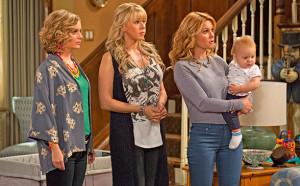 Despite Fuller House’s legion of faults, it’s actually kind of nice. It’s the television equivalent of catching up with old friends you haven’t seen since grade school. Sure, on the surface level, you’ve grown apart during the intervening decades, but you’re still peers with a shared history that leads to a sort of unconditional acceptance. A new show with new characters could never get away with all these flaws.
Despite Fuller House’s legion of faults, it’s actually kind of nice. It’s the television equivalent of catching up with old friends you haven’t seen since grade school. Sure, on the surface level, you’ve grown apart during the intervening decades, but you’re still peers with a shared history that leads to a sort of unconditional acceptance. A new show with new characters could never get away with all these flaws.
If the show chose to focus on the original adults, then this probably would have felt like nothing more than a cheap rehash, and it would have gotten old very quickly. From what we see, none of them have changed since the ‘90s. Danny’s still got a clean streak. Jesse’s still vain. And Joey’s still clinging to his man-childness.
But the focus wisely shifts to the girls who have grown up since the original series. Yes, it’s absolutely contrived that the premise is a gender-reversed version of the original show, with recent widow D.J. raising three boys with the help of sister Stephanie and best friend Kimmy, and yet it feels appropriate, even without youngest sister Michelle. (I certainly can’t blame the Olsen twins for not wanting to re-utter their old catchphrases that pre-date their memories. The show has a little too much fun picking on them about it, though.)
In my case, I haven’t seen a complete episode of the original series since it went off the air. I was a frequent viewer for most of its run, though I did not last until the bitter end. I checked back in for the series finale and never once felt the need to revisit it in reruns. Aside from the rare snippet caught while flipping channels, I’ve been Full House–free for over twenty years. I’d have been fine keeping it that way, and I still have no interest in revisiting the old episodes, but the fact that I had left the show in the past helped me appreciate these new episodes properly. The Tanner girls were children when my sisters and I were children, and we were all close in age. By never watching the reruns, I haven’t trapped these characters in their childhood while I grew up any more than I’ve done so for my old grade school classmates. It makes perfect sense that they would have grown up, too.
This trend of resurrecting old TV shows and movies has been a mixed blessing. Some properties, such as the Muppets, are designed to keep going in various incarnations. Others, such as Arrested Development, were taken from us before their time and earned another shot. And still others, such as The X-Files, should have reached a definitive conclusion and left it at that. An old-fashioned network sitcom is built to last as many seasons as possible, but generally it should eventually have a nice finale and stop as we move on to new shows.
However, thanks to streaming services such as Netflix, Hulu, and Amazon Prime, entertainment is no longer zero sum. Season orders don’t have to be built around the available number of time slots. If a show can make money, it can find a home. So while another round of Full House is something we should have been able to live without, its existence doesn’t necessarily come at the expense of something new and innovative. (John Stamos’s roles as a producer and recurring guest star don’t seem to have conflicted with his starring in Grandfathered, a series that does a far better job of feeling like a classic sitcom with a modern sensibility.)
I couldn’t care less whether Fuller House gets another season. But despite the steady stream of groaners and the obnoxious, outdated laugh track, this set of thirteen episodes was a nice time, one free of any cynicism. It’s just shamelessly Full House. In proper grown-up fashion, it accepts itself without regard for what others might say.
February 4, 2016
Avenging The Fantastic, Part 10: The Machinations of Ultron Begin!
Continuing the read-through of as many Avengers and Fantastic Four–related Marvel comics as possible!
Books Read
Tales of Suspense (starring Iron Man and Captain America) #92-99; Captain America #100-105; Iron Man and Sub-Mariner (just the Iron Man story) #1; Iron Man #1-4; Avengers #51-56, Annual #2; Marvel Superheroes (Captain Marvel) #12-13, (Medusa of the Inhumans) #15; Captain Marvel #1-5; Fantastic Four #74-79; Incredible Hulk #103; Nick Fury, Agent of SHIELD #1-3; years spanned: 1967-68.
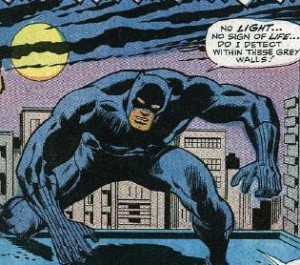 The Revolving Door of Avengers Mansion
The Revolving Door of Avengers Mansion
Captain America can’t return to the team quite yet, but he invites the Black Panther to join in his place. And when the first black Avenger shows up at the mansion, the police promptly arrest him for the murder of the Avengers. It’s all very awkward. But he saves the Avengers from new villain the Grim Reaper (brother of the late Wonder Man and bent on vengeance), and all is well. That leaves us with a lineup of Hawkeye, Goliath, Wasp, and the Black Panther – a formidable but still low-powered bunch.
That Didn’t Take Long – Tales of Suspense #96 (Captain America)
Remember how Captain America quit last time? Made a big fuss, revealed his secret identity to the world and everything? Yeah, well, Cap decides never mind…all in the span of ten pages, because some imposter Caps get themselves in trouble and he has to leap into action to bail them out.
As I said last time, 60s comics burn through plot fast.
“You can’t give up bein’ Captain America…’cause you are Captain America. It’d be easier to turn yer back on Steve Rogers!” –Nick Fury
“I…think you’re…right…Fury! I realize now…a man can’t ever stop being…something that he was born to be!” –Steve Rogers (channeling William Shatner, apparently)
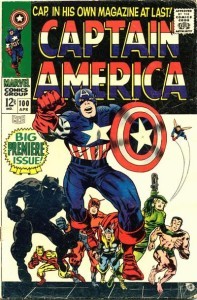 The Best of This Bunch – Tales of Suspense #97-99, Captain America #100
The Best of This Bunch – Tales of Suspense #97-99, Captain America #100
Captain America teams up with the Black Panther and Agent Thirteen to save the world from the malevolent space death ray of Baron Zemo, apparently back from the dead (or is he…?)
This storyline is no work of art, but it’s great fun. And it’s notable for being perhaps the most diverse team-up to date – one white male, one black male, and one white female. And they all act as equal partners, each employing his or her skills to contribute to their victory. Agent Thirteen is no damsel in distress, and the Black Panther is a king, an actual monarch subordinate to no one. This is a pretty big deal for 1968.
Though I honestly can’t decide if the Scooby-Doo ending detracts from the story or adds to its charm.
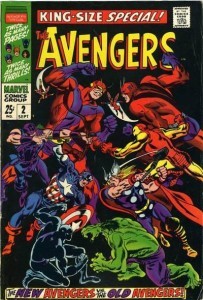 The Runner-Up – Avengers Annual #2
The Runner-Up – Avengers Annual #2
Also no work of art, but also great fun. The aforementioned Avengers lineup, plus the visiting Captain America because he can’t stay away but so long, returns from a time-traveling adventure into a present that’s very different from what they remember. The original Avengers (Thor, Iron Man, Hulk, Giant-Man, and Wasp) have taken over the world!
Semi-new villain the Scarlet Centurion (a later incarnation of Rama-Tut and earlier incarnation of Kang – such is time-travel) confronts the original Avengers, inserting himself at the end of their second issue right before the Hulk quit, and he tricks the team into defeating and imprisoning all other superheroes and then all the super-villains. They achieve supreme power, and of course it corrupts them.
So what we get is the “new” Avengers versus the old, with the fate of the world hanging in the balance (and Hank Pym and Janet Van Dyne get to fight evil versions of themselves since they’re on both teams). Classic old-school comic book stuff right here. Its biggest flaw is that everyone forgets the whole thing in the end, which renders the story inconsequential.
But it’s a heck of a fun roller coaster before it’s nullified, and we get this perceptive quote from good ol’ Cap: “Thru countless ages, mankind has often tried to escape from freedom…into the open arms of tyranny!”
Viewers of Agent Carter recently met a character named Whitney Frost who’s clearly up to something. And at this point in Iron Man’s stories, we also meet a character named Whitney Frost who’s clearly up to something.
The comic book character is a socialite who has an interest in getting close to Tony Stark, but she winds up befriending SHIELD Agent Jasper Sitwell, who has been tasked with protecting Stark. Poor Sitwell doesn’t yet realize that she’s secretly the head of the criminal organization known as the Maggia. More on her later!
Sitwell is another character who has appeared in the MCU, but only the name and SHIELD affiliation remain the same. MCU Sitwell is older, balder, and a lot less loyal. Comic book Sitwell has more in common with Phil Coulson in the first Iron Man movie than his own namesake (they’re not twins by any stretch, though).
And remember Mickey Rourke’s character from Iron Man 2? His comic book inspiration, Whiplash, first appears at the end of Stan Lee’s run on Iron Man in Tales of Suspense. Again, the similarities between the comic book and movie character are nearly zero, other than the use of whips that can cut through pretty much anything.
Oh, and another MCU fella makes his debut…
Ultron, the titular villain of the second Avengers movie, has arrived. But we don’t know much about his origins at this point. In his first story, the robotic villain assembles a new Masters of Evil group to infiltrate Avengers Mansion, where they succeed in defeating the Avengers, all four of them, at least until guest star the Black Knight turns the tides back in the good guys’ favor in part two.
The bulk of this story is the Avengers versus the Masters of Evil. Ultron himself is merely the enigmatic mastermind pulling the strings (but no Pinocchio references, sadly), and he participates in very little of the action outside of punching the butler Jarvis.
This first Ultron story is also the first story in which Jarvis is a major player. The butler betrays the Avengers by revealing the mansion’s secrets. He does so for money, so he can afford treatments for his sick mother. He attempts to redeem himself in the end, and the Avengers forgive him instantly. Specifically, Goliath is the first to act like this betrayal is no big deal. Pretty soon, when we learn who inadvertently created Ultron, Hank Pym’s forgiving nature might make more sense in a self-serving way.
Jarvis actually has two MCU versions – Tony Stark’s AI software and Howard Stark’s butler who assists Peggy Carter in the 1940s. The latter is already a more dynamic character than the comic version, whose defining characteristic is loyalty to the Avengers…well, starting after the major lapse in this story.
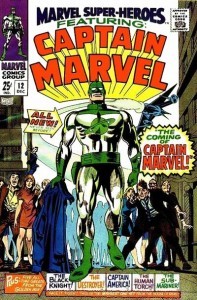 The Coming of Captain Marvel! – Marvel Superheroes #12-13, Captain Marvel #1
The Coming of Captain Marvel! – Marvel Superheroes #12-13, Captain Marvel #1
And now we meet the original Captain Marvel—that’s Marvel Captain Marvel, not the Shazam Captain Marvel. His introduction spins out of the events of Fantastic Four #64-65, when the FF defeated a Kree sentry and Ronan the Accuser. Captain Mar-Vell has been sent on a mission to study Earth and determine whether his people, the advanced alien race known as the Kree, should let it live…or die.
Mar-Vell’s colonel is a jealous man who has decided that the captain, at least, should definitely die. An innocent Earthman gets caught in some crossfire, but rather than mourn the innocent’s passing, Mar-Vell finds the death convenient, because he can steal the man’s identity to gain access to a missile base. Some superhero.
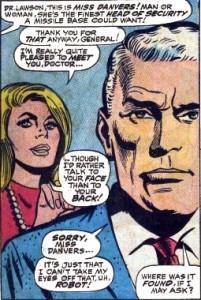 I’m including this version of Captain Marvel for one reason—his series introduces Carol Danvers, who will later become the Avenger known as Ms. Marvel. In today’s comics, she’s at the peak of her popularity and has assumed the Captain Marvel identity herself, and a movie is slated as part of the Marvel Cinematic Universe…eventually.
I’m including this version of Captain Marvel for one reason—his series introduces Carol Danvers, who will later become the Avenger known as Ms. Marvel. In today’s comics, she’s at the peak of her popularity and has assumed the Captain Marvel identity herself, and a movie is slated as part of the Marvel Cinematic Universe…eventually.
When we—and Captain Mar-Vell—first meet Carol, she’s the head of security at the base Mar-Vell is infiltrating, and she quickly becomes suspicious of him. And yeah, I guess she’d have reason for that, wouldn’t she? Marvel Comics’ future greatest heroine shows stellar instincts right off the bat.
But then she’s relegated to damsel-in-distress status the next issue.
“Perhaps it’s only the security officer in me—but I wish I knew more about the helmeted stranger who rescued me! But, somehow, I feel certain that we’ll meet again!” she says in #1.
Don’t worry, Carol. Your day will come.
On the whole, though, there’s an interesting concept behind this Captain Marvel—a superhero whose first loyalty is not to Earth, and he may even be forced to turn against it, if ordered.
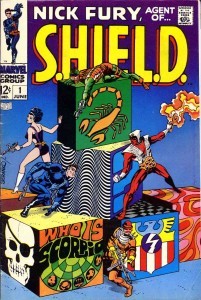 Ah, That Art! – Nick Fury, Agent of SHIELD #1
Ah, That Art! – Nick Fury, Agent of SHIELD #1
The true star of this book is Jim Steranko’s art, especially the way he lays out his sequences. The man was far ahead of his time. While most Marvel books were being overly verbose, writer/artist Steranko opens this series with three wordless pages that allow the pictures to tell the story, and his inventiveness continues throughout. (Of course, Steranko could get verbose, too, but he at least knew to take a break once in a while.)
The story, however, is disjointed, with seemingly unrelated elements coming together in the end. The ending is darker than the standard 60s Marvel fares—a down-on-his-luck comedian experiences a brief moment of hope…and then gets blown up by the source of that hope. Not something you’d see in Captain America or Iron Man. Otherwise, little stands out story-wise. Nick Fury and company battle a generic villain named Scorpio for forgettable reasons. But the art is fantastic.
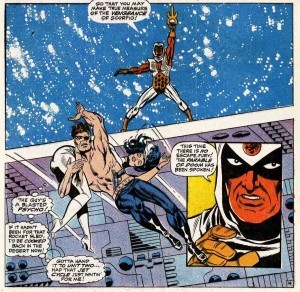 Marvel Unlimited has only the first three of issues of this series available to read, so we’ll have to take a nice long SHIELD break…though not really, as Fury and company are practically regulars in Captain America at this point. This wasn’t a long-lived series anyway. Plus, Steranko left after two more issues, and he’s a tough act to follow.
Marvel Unlimited has only the first three of issues of this series available to read, so we’ll have to take a nice long SHIELD break…though not really, as Fury and company are practically regulars in Captain America at this point. This wasn’t a long-lived series anyway. Plus, Steranko left after two more issues, and he’s a tough act to follow.
Meanwhile…
–In Captain America #101-102, Nick Fury tells Agent Thirteen that Captain America died in a battle with the Red Skull so she wouldn’t try to join him on a dangerous mission. Both men think this is a good idea, but she doesn’t fall for it. In hindsight, knowing some of the plot points that will arise in future years, this almost counts as a foreshadowing…purely by accident, I’m sure.
–Agent Thirteen gets a name—Sharon Carter. Related to Peggy? Perhaps!
–“Forgive me for…being a woman, Mr. Sitwell…” –Natasha, the former Black Widow, sincerely and unironically in Avengers #52. Oy vey.
–Time moves slowly in the comic book universe…except when it comes to pregnancies. Though the Fantastic Four have barely aged from 1961-68, the Invisible Girl’s pregnancy swiftly progresses from “just announced” (FF annual #5/FF #65) to “she’s almost due” (FF #75) in a span closer to real-world time than Marvel time. And she doesn’t even look the least bit pregnant. Invisibility powers do come in handy, don’t they? This is one of the earliest comic book pregnancies (quite possibly the first with two super-parents), and it introduces the trope of problematic super-pregnancies…a trope that actually makes a lot of sense when one or both parents have been exposed to DNA-altering levels of radiation.
–“That’s the one thing wrong with demanding complete obedience! My men become human robots—unable to think for themselves!” –Red Skull, Captain America #103, the same issue in which Cap and the Skull have a rousing conversation about equality and tyranny while in a fistfight—which as we all know is the perfect time for philosophical discourse.
–Medusa (of the Inhumans and formerly of the Frightful Four) stars in Marvel Superheroes #15, making her quite possibly the first female character since World War II to headline a Marvel superhero book, even if it is just for one issue. Naturally, her primary motivation is to help her man, Black Bolt, overcome his inability to speak without destroying everything around him. For the era, it’s still good progress.
–“Indirectly, I’m responsible for her father’s death! If only there were some way to make it up to her!” –Tony Stark, genius, Iron Man #3
–Turns out Pepper Potts and Happy Hogan got married off-screen (unless I just missed or forgot). So that ends that romantic interest for Tony Stark.
To Be Continued…
Well, we’ve met Ultron, so that must mean the Vision is right around the corner!
January 7, 2016
Avenging The Fantastic, Part 9: The Secret Origin of Dr. Don Blake!
And we’re back—in a bold new direction! (Well, technically not bold, but 60s Marvel and hyperbole do go hand in hand.) As the Marvel Comics Universe continues to evolve, so must this column. I’m playing around with the format a bit, but one thing remains the same: We’re continuing the read-through of as many Avengers and Fantastic Four–related Marvel comics as possible!
Books Read
Fantastic Four #56-73; Thor #141-159; Tales to Astonish (starring the Hulk) #92-101; Incredible Hulk #102; Strange Tales (starring Nick Fury and SHIELD) #150-168; Tales of Suspense (starring Iron Man and Captain America) #89-95; Avengers #36-50; years spanned: 1967-68.
A confession
Lifelong Marvel fan though I am, I must confess I’ve entered into a bit of a slog here. By this point, Marvel has grown confident in its house style. The books have hit a comfortable rhythm, which was no doubt great for young fans at the time, but it doesn’t hold up so well against modern adult sensibilities. Dialogue is over-written. Captions explain more than they need to. And while everything is still brimming with wonderful imagination, it doesn’t feel as special as it did when most of the characters were making their debuts. And that makes perfect sense—these books weren’t built for long, multi-year narratives. They were disposable entertainment kids would get into for a few years before moving on to other hobbies.
But that’s just story-wise. Art-wise, however…
A broader palette
Jack Kirby dominated the art scene in the beginning and helped launch most of these characters. As this is a visual medium, Kirby deserves as much credit as Stan Lee for introducing these characters the right way. He had a kinetic, larger-than-life style that particularly suited the Fantastic Four and Thor, which he continued to illustrate in this batch of issues.
But other notable artists had begun emerging with their own distinct styles that suited the books they were assigned to.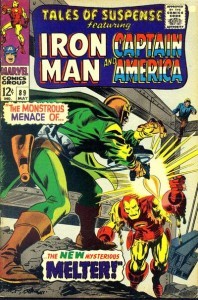 Jim Steranko, as both writer and artist, infused new life in the Nick Fury series in Strange Tales, bringing a cinematic sensibility to the stories. For example, ST #167 devotes a four-page spread to a single panel that’s jam-packed with action—that’s about as wide-screen as comics can get. He also gets a tad psychedelic here and there.
Jim Steranko, as both writer and artist, infused new life in the Nick Fury series in Strange Tales, bringing a cinematic sensibility to the stories. For example, ST #167 devotes a four-page spread to a single panel that’s jam-packed with action—that’s about as wide-screen as comics can get. He also gets a tad psychedelic here and there.
Over in Iron Man’s series in Tales of Suspense, Gene Colan drew with a more down-to-earth style that’s appropriate for a superhero who’s all tech and no natural super-powers. You get the sense that Colan’s characters are moving more like people than cartoons.
John Buscema gave The Avengers a suitably dynamic style, full of expressive faces.
All these gentlemen had a tremendous influence on the medium. I admit, talking about artistic composition isn’t my strong suit, so, to borrow from the great Levar Burton, don’t take my word for it…check out the images I’ve included in this post.
The Revolving Door of Avengers Mansion
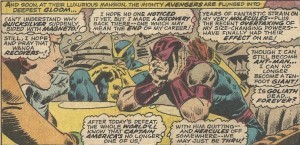 The Avengers’ ranks were beginning to swell up, with Hercules joining Captain America, Goliath, Wasp, Hawkeye, Quicksilver, and Scarlet Witch. Plus, Black Widow tagged along with the team awhile and nearly became a member. And potential recruit (and indeed, future Avenger) Black Knight was introduced in #48. But a misunderstanding sent Black Knight running off in a tizzy at the end of his first appearance. Black Widow quit both the superhero and the spy games for now. Captain America resigned from his super-heroic life (more on that below). Magneto lured Quicksilver and Scarlet Witch back to the Brotherhood of Evil Mutants (back in the day when bad guys owned their evilness…reclaiming the pejorative, I guess?). And Hercules found his way back to Olympus. This leaves us with only Hawkeye, Wasp, and Goliath—and Goliath’s powers aren’t even working properly (must be Tuesday).
The Avengers’ ranks were beginning to swell up, with Hercules joining Captain America, Goliath, Wasp, Hawkeye, Quicksilver, and Scarlet Witch. Plus, Black Widow tagged along with the team awhile and nearly became a member. And potential recruit (and indeed, future Avenger) Black Knight was introduced in #48. But a misunderstanding sent Black Knight running off in a tizzy at the end of his first appearance. Black Widow quit both the superhero and the spy games for now. Captain America resigned from his super-heroic life (more on that below). Magneto lured Quicksilver and Scarlet Witch back to the Brotherhood of Evil Mutants (back in the day when bad guys owned their evilness…reclaiming the pejorative, I guess?). And Hercules found his way back to Olympus. This leaves us with only Hawkeye, Wasp, and Goliath—and Goliath’s powers aren’t even working properly (must be Tuesday).
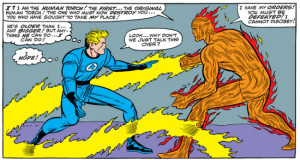 A Tale of Two Human Torches – Fantastic Four Annual #4
A Tale of Two Human Torches – Fantastic Four Annual #4
Interesting little bit of trivia: the Fantastic Four’s Human Torch is not the first Human Torch, just the first one who’s actually human. Back in 1939, the image of a fiery character graced the cover of Marvel Comics #1. This was a combustible android named the Human Torch, and he was one of the company’s most popular characters throughout World War II, right along with Captain America and Namor the Sub-Mariner.
So naturally, it was past time for Stan Lee and company to dust him off and have him fight the new Human Torch.
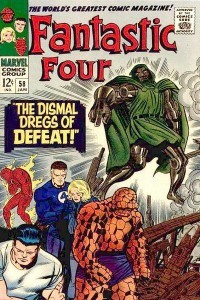 The Best of This Bunch – Fantastic Four #57-60
The Best of This Bunch – Fantastic Four #57-60
This storyline is the highlight of this batch of issues—almost by default, given the weak competition, but it truly is a fun time, a prime example of big ‘60s-style Marvel action. Doctor Doom steals the Silver Surfer’s incredible cosmic power and now has the raw physical might to match his towering ego—until that very ego leads to his downfall, of course.
“But wait! I just remembered one thing—! Reed has a portable metabolism accelerator back at his lab! If anything can snap Ben out of it—that oughtta do it!” –Human Torch, as if he could possibly forget a portable metabolism accelerator and its practical battlefield applications, in FF #58
The Kree Are Coming, the Kree Are Coming! – Fantastic Four #64
This issue is notable for the first mention of the alien Kree, whom viewers of the Agents of SHIELD television series have been hearing about for a while now. Mr. Fantastic, Invisible Girl, and the Thing encounter an ancient Kree sentry that had been dormant on Earth for ages. It comes to life, and, once again, big 60s-style Marvel action ensues. Meanwhile, Johnny Storm falls further in love with Crystal (of the Inhumans), though their moment is interrupted by a giant teleporting dog. The things you’ve gotta watch out for in the MU…
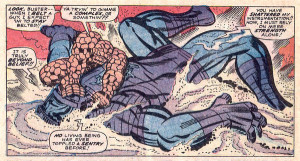 “Just do as I told you, girl! And don’t question my orders! This isn’t your husband talking—it’s Mr. Fantastic—the leader of the world’s greatest team—!” –the ever-modest Reed Richards
“Just do as I told you, girl! And don’t question my orders! This isn’t your husband talking—it’s Mr. Fantastic—the leader of the world’s greatest team—!” –the ever-modest Reed Richards
“I have not seen, nor heard from the Kree for untold ages! Perhaps the supreme race is long-since dead—or perhaps they are just departed—to return again—some day!” –the sentry
Cue ominous music. And yes, the Kree do start coming. The next issue introduces Ronan the Accuser (the nonentity villain in the otherwise excellent Guardians of the Galaxy movie).
Justifying Don Blake – Thor #159
Some readers may have been wondering why, out of all the Asgardians, Thor alone had to be saddled with a mortal alter ego. The answer arrives at long last, and—no surprise—it resembles what we saw in the first Thor movie.
Thor needed to learn humility, so Odin sent him to Earth as Don Blake, a medical student with an injured leg and no memory of his life as Thor. He also sent down Mjolnir so Blake would find it when he was ready. This mirrors the movie, where Odin sought to teach the same lesson, but rather than creating any new identity, he simply banished Thor to Earth with his memory intact but without any godly powers.
The bigger difference, though, is the movie’s banishment of Thor is part of a clear character arc. This explanation of the Don Blake puzzle feels like an afterthought.
It makes sense that Stan Lee would want to give a superhero as powerful as Thor a weakness that could put him in genuine peril, and having a mortal alter ego—one he’d revert to if he was separated from his hammer for more than sixty seconds—would accomplish that.
But as the series fleshed out Asgard and the many supporting characters who inhabit the mythical realm, and as the series spent less and less time on Don Blake, any Blake appearance started feeling out of place. Why would a god like Thor bother with such an identity, especially after he wasn’t allowed to date Jane Foster? (Sif has been proving herself a much better romantic interest for him, by the way.)
Stan Lee came up with a great answer, one with a very mythological feel—the god who must learn humility. But now that the character is aware of the fiction of his double life, the question comes boomerangs back: Why bother?
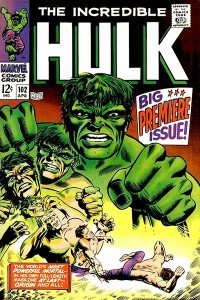 Let’s Try This Again – Incredible Hulk #102
Let’s Try This Again – Incredible Hulk #102
The Hulk gets promoted back into his own solo series, picking up the numbering from Tales to Astonish, which he had been sharing with Namor and, earlier, Giant-Man. Hulk’s first solo series lasted six issues, none of which hold up especially well. This “first” issue doesn’t have much to boast about either.
The final two issues of TTA, respectively, saw the Hulk mind-controlled by the Puppet Master to do battle against Namor, and manipulated by Loki to attack Asgard and Thor’s buddies, the Warriors Three. Issue #102 continues in Asgard, and rather than capitalize on the exotic locale or exploit the fish-out-of-water scenario, Hulk basically just fights some trolls after the Enchantress interrogates Bruce Banner about her beloved Hercules, whom he knows nothing about.
Also, the Warriors Three meet with some mystic to learn about the Hulk’s origins so new readers can get caught up to speed. This was back in the day when most copies of Hulk #1 had long since been thrown in the garbage, so the flashbacks served a practical purpose at the time. It’s kind of like when television shows had clip episodes full of old scenes that weren’t likely to air again. For the modern reader, however, direct flashbacks that add no new details become pages to skim past.
So far, the Hulk just isn’t working as a solo character, which mirrors his situation in the Marvel Cinematic Universe. His pre-MCU film was an ambitious flop, and his more successful second outing nevertheless remains one of the weakest MCU films to date. He’s at his best when creating difficulties for other Marvel characters to deal with. This isn’t to say that he can’t work as viable solo character—just wait until writer Peter David gets his hands on the title in the 1980s—but the Hulk sure is slow reaching his potential.
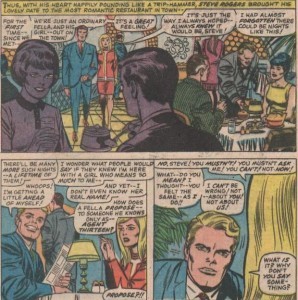 A Captain in Love! – Strange Tales #95 (Captain America)
A Captain in Love! – Strange Tales #95 (Captain America)
“How does a fella propose—to someone he knows only as—Agent Thirteen?” –Steve Rogers, while on his first real date with Agent Thirteen.
Geez, Cap, I know you spent decades on ice and probably feel like you’ve got to make up for lost time, but damn, the Sentinel of Liberty makes up his mind fast. Or love is just instantaneous in the MU (like with the Human Torch and Crystal’s whole obsessive-love-at-first-sight storyline in Fantastic Four). But go ahead – ask her to marry you before you ask what her name is.
Agent Thirteen (whom we met in the Winter Soldier film) had enough sense to turn him down, primarily because of her sense of duty toward SHIELD. But the whole thing inspires Captain America to quit so he can take time to figure out who Steve Rogers truly is.
It all feels like it’s coming out of nowhere…but that’s how things rolled in those days. They burned through plot fast and furiously, developing ideas and running with them.
So what if it’s rushed? It’ll still be fun to see how it plays out. Probably quickly, I’d wager.
To Be Continued…
Will Steve Rogers reclaim his rightful role as Captain America? Will Thor finally realize what a waste of time Donald Blake is? Will the Hulk figure out how to be interesting? Will the 60s ever end? Tune in a few weeks from now for more Marvel-ous mayhem!
January 4, 2016
Doctor Who Series 9 Ranked From Worst To Best
(Originally posted at Smash Cut Culture.)
SPOILERS ahead.
My previous ranking of every modern Doctor Who episode had become out of date…until now. Series 9 wrapped up earlier this month, and this year’s Christmas special was the last new episode until probably next fall. Time for an update.
I’ve inserted the new episodes into the overall worst-to-best rankings, which debuted in four parts early this year:
But if you just want to focus on the newest season, I’m including the Series 9–only list below (same text I’m inserting into the full list). Note that this was a more serialized season than previous years. It featured a mix of conventional two-parters (The Magician’s Apprentice/The Witch’s Familiar, Under the Lake/Before the Flood, and The Zygon Invasion/The Zygon Inversion) and episodes that directly continued into each other while each maintaining its own flavor (The Girl Who Died/The Woman Who Lived and Face the Raven/Heaven Sent/Hell Bent). The episodes in the latter category are separately ranked because their different flavors merit individual attention.
This was an excellent season on the whole, a big improvement over the past few years, with no real clunkers in the mix. But, as always, some are better than others.
Again, SPOILERS!
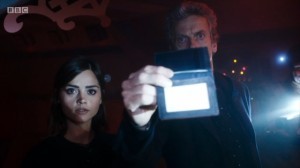 #10 Sleep No More: The only self-contained episode in Season 9 never reaches a proper resolution. It introduces the fascinating sci-fi concept of technology that can eliminate the need for most sleep and thereby increase productivity, but then the episode decides it would rather play around with generic monsters composed of eye dust. Clever use of the found footage trope gives the story a distinctive look and feel, but the cliffhanger ending prevents it from becoming anything more than an interesting gimmick.
#10 Sleep No More: The only self-contained episode in Season 9 never reaches a proper resolution. It introduces the fascinating sci-fi concept of technology that can eliminate the need for most sleep and thereby increase productivity, but then the episode decides it would rather play around with generic monsters composed of eye dust. Clever use of the found footage trope gives the story a distinctive look and feel, but the cliffhanger ending prevents it from becoming anything more than an interesting gimmick.
#9 The Magician’s Apprentice/The Witch’s Familiar: Season 9 gets off to a decent start, but it carries over the chief flaws of the previous few seasons— an over-reverence for the Doctor and prioritization of what’s cool over what makes sense (why is there a cup of tea on the Daleks’ homeworld?). The inclusion of Missy—the most entertaining incarnation of the Master—elevates the story. She and Clara make an exceptionally fun duo.
#8 The Husbands of River Song: It starts off a bit too silly, which is excusable in its role as a Christmas special. As an episode of Doctor Who, however, it comes dangerously close to riding off the rails until, in the last 15 minutes or so, the wacky antics give way to an emotionally satisfying conclusion to River Song’s story. Granted, this is her third or fourth “ending” at this point, but it’s also her best ending.
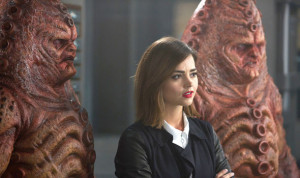 #7 The Zygon Invasion/The Zygon Inversion: The two-part running time feels slightly too long. Clara getting somehow trapped in her own head a second time in less than a year is one time too many. And the anti-war message is a tad too preachy…until the end. The Doctor’s speech at the climax is extraordinary, and it needed this particular Doctor (an older face combined with the acting chops of Peter Capaldi) to make it resonate.
#7 The Zygon Invasion/The Zygon Inversion: The two-part running time feels slightly too long. Clara getting somehow trapped in her own head a second time in less than a year is one time too many. And the anti-war message is a tad too preachy…until the end. The Doctor’s speech at the climax is extraordinary, and it needed this particular Doctor (an older face combined with the acting chops of Peter Capaldi) to make it resonate.
#6 Under the Lake/Before the Flood: If there’s such a thing as a “typical” Doctor Who story, it’s this two-parter, which features the familiar tropes of a base under siege, an apparently supernatural menace that turns out to have technological origins, and the Doctor facing his own mortality. It doesn’t break the mold, but it fits it very well.
#5 Hell Bent: A different kind of season finale for Doctor Who, in that no external threat is imperiling any world. Instead, the Doctor goes too far in trying to save his companion, thereby jeopardizing the universe in the process. It’s a bit of a cheat that gives us an alternative ending for Clara, one less effective than her death in “Face the Raven” but a happier one that could lead to fun possibilities in either future episodes or viewers’ imaginations.
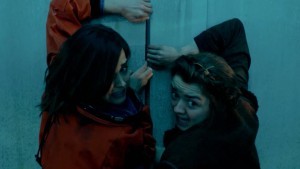 #4 The Girl Who Died: A bunch of inept Vikings need to defeat powerful alien warriors. What begins as a fun romp takes a serious turn at the end as the Doctor decides to break the rules to save an innocent life…and the question of whether that was the right call remains ambiguous.
#4 The Girl Who Died: A bunch of inept Vikings need to defeat powerful alien warriors. What begins as a fun romp takes a serious turn at the end as the Doctor decides to break the rules to save an innocent life…and the question of whether that was the right call remains ambiguous.
#3 The Woman Who Lived: A compelling look at immortality—and, by extension, mortality. Guest star Maisie Williams becomes a viable recurring character as the immortal “Me” as she sells the pain and loneliness of a too-long life. The 17th setting century setting lends additional weight to her melancholy—at this point, the character has only endured through eras of human history when (to borrow from Thomas Hobbes) life was nasty, brutish, and short.
#2 Face the Raven: Ironically, the companion with the least consistent characterization gets the strongest character-based exit (well, her true exit is two episodes later, but her natural life ends here). Clara started as a walking plot puzzle in Season 7, but in her final season she settled into a far more compelling role: the Doctor’s best friend who holds him accountable to be the kindest and most compassionate he can be while she grows more Doctor-like herself. But in this heartbreaking episode, we’re shown how no human could ever be the Doctor. Clara thinks she’s being clever to save a friend, and her heart is absolutely in the right place. But her overconfidence leads to her downfall, and the responsibility is all hers. A textbook example of how to kill a character in a meaningful way.
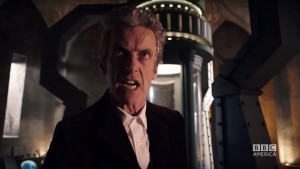 #1 Heaven Sent: It’s Doctor Who as a one-man show (almost), and it’s phenomenal. Immediately after the death of his closest friend, the Doctor is transported into a strange castle that’s really one massive torture/confession chamber with seemingly no way out. Gradually, he pieces together a solution, the one way to escape and get where he needs to go without revealing a secret he’s unwilling to tell—and the exit is the ultimate torture. He has to punch his way through an incredibly dense, thick wall, and after every few punches, he has to get killed and start the whole thing over, without any memory of his previous attempts, his grief once again fresh, just so just he can achieve a tiny bit more progress chipping away at that mighty wall. But he perseveres nevertheless. The moment when he realizes the hell he has to put himself through might be Peter Capaldi’s finest bit of acting as the Doctor thus far, a bar that was already high.
#1 Heaven Sent: It’s Doctor Who as a one-man show (almost), and it’s phenomenal. Immediately after the death of his closest friend, the Doctor is transported into a strange castle that’s really one massive torture/confession chamber with seemingly no way out. Gradually, he pieces together a solution, the one way to escape and get where he needs to go without revealing a secret he’s unwilling to tell—and the exit is the ultimate torture. He has to punch his way through an incredibly dense, thick wall, and after every few punches, he has to get killed and start the whole thing over, without any memory of his previous attempts, his grief once again fresh, just so just he can achieve a tiny bit more progress chipping away at that mighty wall. But he perseveres nevertheless. The moment when he realizes the hell he has to put himself through might be Peter Capaldi’s finest bit of acting as the Doctor thus far, a bar that was already high.
October 29, 2015
Ranking the Marvel Cinematic Universe from Worst to Best
Originally posted at Smash Cut Culture.
The Internet clearly doesn’t have enough lists, so here’s another.
Many have attempted to rank the movies comprising the Marvel Cinematic Universe. Fewer have dared to add the four complete seasons of MCU television and Netflix series into the equation. I shall somehow rise to this challenge to ensure the Internet does not experience a shortage of lists. This was not easy, Internet. I swear, the top six were all neck-and-neck, and it came down to a photo-finish.
This ranking is from worst to best, not horrible to great. I’ve enjoyed all of these to varying extents, and the “varying” is what I’m measuring. None are bad. Conversely, none are works of towering artistic genius either. But it’s all damn fine entertainment worth revisiting.
SPOILERS ahead.
So, with that warning out of the way…
Here…we…go!
16. Agents of SHIELD season 1—It’s not a bad show by any stretch, but nothing in the MCU feels more pedestrian than Agents of SHIELD. The main problem with this first season is that it starts far too early. While the early episodes are entertaining enough, and the pilot shows a lot of promise, the story doesn’t get truly exciting until it ties into the events of Captain America: The Winter Soldier. Likeable cast, solid concept of exploring the overlooked corners of the MCU, and some strong individual episodes, but on the whole it seldom feels like it’s inhabiting a suitably epic world.
15. Agents of SHIELD season 2—The second season has a different atmosphere to it, and the show is stronger for it, but many of the same criticisms apply. The introduction of the Inhumans is a big plus, but even their presentation is rather tame for a secret civilization of super-powered people who are descended from aliens. Limitations of network television are no doubt to blame. Given those limitations, the cast and crew do a fine job. Room for improvement remains, and I think we’re starting to see more of that in season 3 so far (not included in this list because it’s just getting started). Gotta give AOS credit for this: It gets better as it goes, and it’s always building on itself.
14. The Incredible Hulk—The MCU’s beta test. Whereas the first Hulk movie aimed high and missed, this one targets a much lower bar and mostly succeeds in what it sets out to do. Mindless Hulk-smash action ensues, kind of forgettable, but hey, it’s fun and true to the spirit of the Hulk. One objective it fails in, however—making the case for more solo Hulk films.
13. Iron Man 2—A letdown from the unexpected pleasure of the first film, but thanks to a great cast, it remains entertaining despite itself. This is the first MCU movie that needs to worry about setting up future movies, but they neglected to figure out how to handle it gracefully. Worse than that, Tony Stark’s character has regressed from the development he achieved in the first movie. The movie seems to want to tackle the storyline from the comic books in which Stark became an alcoholic, but it never fully commits or comes to a satisfying resolution. Instead, the health problem driving Stark’s behavior gets resolved with a quick injection from Nick Fury and Black Widow. So yeah, it’s a mess, but it’s a fun mess. How can you not enjoy Tony Stark telling off Congress?
12. Thor: The Dark World—By this point, the MCU has “good dumb fun” down to a science, and that’s basically all this movie is. Nothing wrong with that once in a while. It is sadly a waste of Christopher Eccleston (the Ninth Doctor himself) as the villain Malekith. Of all the underdeveloped bad guys in the MCU—and they are legion—Malekith wins the prize for least developed. That’s saying a lot. But balancing him out is the MCU movies’ best villain, Loki, who is easily this film’s MVP.
11. Agent Carter season 1—Hayley Atwell can carry a show. The series doesn’t break any new ground, but that almost seems to be the point—it revels in its retro charm, which is further bolstered by the wonderful chemistry between Atwell’s Peggy Carter and James D’Arcy’s Edwin Jarvis. It’s the stuff of classic television—not extraordinary television, but classic. A good time indeed.
10. Ant-Man—If you’re going to make a movie about a superhero who can shrink to insect size and control ants…then of course you want to make it a heist movie that explores the dynamic between fathers and daughters…right? Apparently so, because while Ant-Man doesn’t reach any new heights of greatness (I guess he’s too short—ba-dum-ching!), it’s a solidly entertaining film that adds something different to the MCU and doesn’t feel like a rehash of previous concepts. It’s missing that special spark that Guardians of the Galaxy brought to its ridiculous, obscure characters, but it’s still an enjoyable outing with more emotional weight than you’d ever have expected an Ant-Man movie to carry. Added bonus: The tie-ins to the broader MCU world feel more organic than usual and don’t interfere with the main story.
9. Iron Man 3—Perhaps the most controversial MCU film, but I actually like the twist with the Mandarin. I truly did not see it coming, and that’s a rare feat indeed. Way to mess with our comic book expectations, MCU. The film nevertheless has lots to nitpick, and I understand why some don’t like it, but damn if it isn’t a fun time with several exciting set pieces. Whereas the previous Iron Man film got muddled in trying to set up future pieces of the universe, this one gets to draw inspiration from previous events to tell its own story—a much more effective way to go.
8. Thor—Never in an Asgardian lifespan would I have expected to enjoy a Thor movie, but director Kenneth Branagh and company pull it off admirably. Thor gets a nice arc as he progresses from hot-headed “youth” to responsible hero. Switching between Asgard and New Mexico risks tonal whiplash, but injecting the epic into the mundane suits the spirit of Marvel.
7. Avengers: Age of Ultron—While the first Avengers film served as the MCU’s then-culmination and needed to succeed on its own merits, lest the grand Marvel experiment grind to a halt, this sequel does not have that luxury and suffers for it. It’s still a great time, though, even if future setups interfere with Ultron’s development as a compelling antagonist. This is a villain who, in the comics, is basically the “son” of an Avenger (Hank Pym there, Tony Stark and Bruce Banner here), and that fuels his Oedipal complex of wanting to kill and replace his “father.” Very appropriate for a robot who wants to supplant humanity with machines. That doesn’t shine through as clearly in the film. Despite that, the movie captures the essence of an Avengers comic, with plenty of thrilling action and fun interplay between great characters. And a floating city!
6. Guardians of the Galaxy—It’s like someone dared Marvel to build a franchise around the most obscure characters, just to see if they could, like some sort of twisted fraternity hazing prank. Well, they could. Clearly director James Gunn just gets this kind of stuff. Intelligent space raccoons, talking trees—he gets it and has a blast with it. Thus, we have a blast. The soundtrack is key—hands-down, the MCU’s best. Juxtaposing cheesy-in-a-good-way 70s songs with space adventure is brilliant, and it grounds even the most ridiculous elements. It all has such heart to it. That opening scene, ohh, that one will getcha…
5. Captain America: The First Avenger—A great introduction for the MCU’s most shamelessly heroic character, and the best, most earned chemistry between the lead and romantic interest by far. Do you realize how hard it is to craft a morally perfect hero and have him be compelling?—especially in today’s more cynical age. When is perfection ever interesting? But by focusing on Captain America’s drive to do right and his underdog roots, the movie succeeds. There’s a reason a sizable chunk of Cap’s World War II service is covered in montage but the movie takes its time building up to Steve Rogers becoming Captain America. That’s not a case of starting the story too early—that is the story, and it’s a great, inspiring one. Just ignore the fact that he basically needed to take a bunch of steroids to become a super-soldier.
4. Iron Man—This was such a breath of fresh air when it came out, and it still holds up as a great adventure film, structured around Tony Stark building himself into a better person, literally and figuratively. Its sense of humor is vital to its success—a superhero film can’t take itself too seriously, but the characters do need to take their predicaments seriously. This movie nails that balance. It also sets the precedent of the villain being little more than an afterthought, but nothing’s perfect.
3. The Avengers—So there’s this joke…A billionaire, a Norse god, a World War II throwback, and a modern-day Jekyll and Hyde walk into an alien invasion…oh, and they’re joined by some super-spies…and it actually works. That’s movie magic right there. It’s an impressive juggling act that only someone like writer/director Joss Whedon could pull off after years of successfully juggling tonal shifts in Buffy the Vampire Slayer and Angel. It’s the sort of pure, shameless, brightly colored fun more summer blockbusters should aspire to…
2. Captain America: The Winter Soldier—…Or, you could put an unabashed hero in a morally ambiguous spy thriller that evokes real-world national security issues, and that works, too. The true antagonist in this film is a changing world, a more dangerous world than the good ol’ days. Steve Rogers’ man-out-of-time status evokes a feeling many should be able to relate to as we compare our present adult era with the seemingly innocent (in hindsight) past we grew up in. But even the past isn’t all that secure either, as shown by Cap’s old best friend returning from the grave as a deadly (if brainwashed) Hydra operative. The big Hydra reveal isn’t merely a set-up for future MCU episodes; it’s actually a pivotal part of this story that, as a side benefit, has repercussions on the other properties within this fictional world. Marvel’s finest movie, which leaves us with…
1. Daredevil season 1—The Netflix format flatters the MCU. A run of 13 episodes gives everything room to breathe but not a lot of extra room to feel padded. Because of this, the villain finally gets enough attention to develop into a fully-formed character. A well-constructed nemesis like Wilson Fisk is the ingredient so many otherwise fantastic MCU movies were missing, and Daredevil reaps the benefits of this advantage. Amazing fight choreography doesn’t hurt either—I love how Matt Murdock seems physically tired after a fight. But here’s the show’s real key component—love. Every major character, even the villains, loves something and/or someone—the city, a friend, a relative, a job, a significant other—and that love contrasts against the dark storylines and brutal scenes, preventing any sort of bleak nihilism. This is not surprising when we see no fewer than three Buffy and Angel alumni on the writing staff (show creator Drew Goddard, showrunner Steven S. DeKnight, and episode writer Douglas Petrie). Love elevates Daredevil to the top of the MCU mountain.
All right, Jessica Jones. That’s what you have to beat.
October 25, 2015
Celebrate Halloween with Rip, Serissa, and assorted ghosts…for free
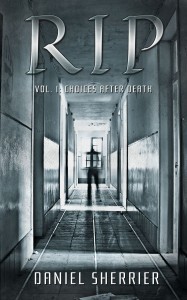 Boo! RIP vol. 1: Choices After Death is having its first-ever free promotion Oct. 25 through Oct. 28. Sure, the original novelette was a free standalone ebook for a while, but that’s gone and only this set of four novelettes and a short story remains.
Boo! RIP vol. 1: Choices After Death is having its first-ever free promotion Oct. 25 through Oct. 28. Sure, the original novelette was a free standalone ebook for a while, but that’s gone and only this set of four novelettes and a short story remains.
Just in time for Halloween. The perfect time to read about a young guy beating up ghosts.
Also, Earths in Space vol. 2: We Must Evolve will embark on my maiden voyage into the world of Kindle Countdown Deals Oct. 27 to Nov. 3, so keep an eye out for that.
And while I’m giving things away for free or nearly free, I’ll continue working on Terrific. Once I finish that novel, I’ll return to the paranormal world of RIP for two more volumes, circle back around for a third Earths in Space, and…well, that’s as far ahead as I can think right now.
So…have fun reading.
October 1, 2015
Avenging the Fantastic, Part 8: Enter the Black Panther!
Continuing the read-through of as many Avengers and Fantastic Four–related Marvel comics as possible!
Fantastic Four #52-55; Thor #131-140; Tales to Astonish (starring the Hulk) #80-91; Strange Tales (starring Nick Fury & SHIELD) #146-149; Tales of Suspense (starring Iron Man and Captain America) #79-88; The Avengers #30-35; years: 1966-67.
Fantastic Firsts
Captain America’s arch-foe the Red Skull arrives in the modern era (relative to World War II, anyway) in Tales of Suspense #79, and the story also introduces the Cosmic Cube—known to Marvel Cinematic Universe viewers as the Tesseract.
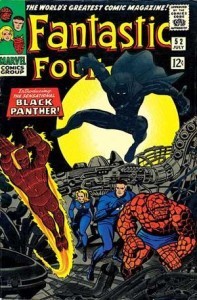 Marvel gets its first black superhero, the Black Panther, ruler of the African nation Wakanda, in Fantastic Four #52, and the next issue introduces his foe, Ulysses Klaw, who was seen in Avengers: Age of Ultron. The super-metal vibranium also debuts.
Marvel gets its first black superhero, the Black Panther, ruler of the African nation Wakanda, in Fantastic Four #52, and the next issue introduces his foe, Ulysses Klaw, who was seen in Avengers: Age of Ultron. The super-metal vibranium also debuts.
Sif is reintroduced as a skilled warrior, more along the lines of her movie counterpart (though comics Sif is Heimdall’s little sister), in Thor #136.
Future superhero (and future Goliath) Bill Foster first appears as Hank Pym’s lab assistant in Avengers #32.
The Abomination, the monstrous villain of The Incredible Hulk movie, gets his first exposure of gamma radiation in Tales to Astonish #90.
And several other recurring villains debut in this group of issues: the Super-Adaptoid, the Serpent Society, Ego the Living Planet, and the Living Laser, as well as neither-villain-nor-hero the High Evolutionary.
We also experience the first crossover between titles, as Iron Man’s battle against the Sub-Mariner directly continues from Tales of Suspense #80 into Tales to Astonish #82. And thus a trend began, one that has never ended to this very day.
The Revolving Door of Avengers Mansion
Quicksilver and Scarlet Witch abruptly take a break to fix their inexplicably diminishing powers—the effects of which we never see in action, but I suppose someone had to prevent the Avengers from having a stable lineup for more than a few issues. This also allows Goliath to be repeatedly referred to as the most powerful Avenger—even though he has no power aside from being ten feet tall. The team must really miss Thor and Iron Man.
–Jane Foster is finally out of the picture, for a short while at least. Odin, ever crafty, pretends to approve of Thor’s relationship with Jane, but he insists she must become an immortal in order to wed one. Jane is brought to Asgard and given the power of flight—and she quickly reveals herself to be a cowardly wimp who can’t handle Asgardian life.
“…I never dreamed [flying] could be so terrifying—such an alien, unnatural sensation!” Jane! You’re flying! Just enjoy it! Agh!
“I must get out! I must leave—get away—escape this world of fear and madness!” I know they say opposites attract, but this is a little over the top.
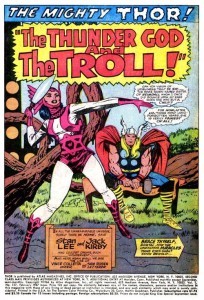 The only similarity between comics Jane and Natalie Portman’s character at this point is the attraction to Thor. And neither version of the couple shows a ton of chemistry or any reason for a special bond to form between them—just two pretty people being drawn to each other because the story calls for it.
The only similarity between comics Jane and Natalie Portman’s character at this point is the attraction to Thor. And neither version of the couple shows a ton of chemistry or any reason for a special bond to form between them—just two pretty people being drawn to each other because the story calls for it.
Odin sends Jane back to Earth and sets her up with a new nursing job. Thor is heartbroken for about two seconds, until he meets Sif for the first time in many years. He’s instantly attracted to her and forgets all about Jane for the next few issues. Typical dude.
“Thou art Sif! The raven-tressed child whom once I dangled upon my knee! But, by my mallet—thou art child no longer!” Okay, that’s not typical. That’s just creepy.
Sif, however, has been in love with Thor since childhood, and her motivation for developing her warrior skills was to impress him.
–Hulk reverts to Bruce Banner in full view of a bunch of people. Seems he’s Hulked himself right out of the secret identity closet.
The Marvel Cinematic Universe gets criticized for having under-developed villains—and for good reason. The Red Skull in the first Captain America movie is a prime example, and looking at his comic book roots, it’s easy to see how that happened (aside from wanting to devote more valuable screen time to characters like Cap and Peggy Carter).
The Red Skull is a stand-in for every wicked Nazi there ever was, and there’s less nuance with Nazis than any other political movement of the past century. We all agree they represented evil. The Red Skull, then, represents pure evil. That can create a powerful obstacle for Captain America to fight, but more a force of nature than a fully-formed character.
Many great villains view themselves as the hero. Not so with the Red Skull. He spells it out himself in Tales of Suspense #80: “So long as evil lives—to muster the forces of bigotry, hatred, and oppression—the fight goes on! So long as men take liberty for granted—so long as they laugh at brotherhood—sneer at honesty—and turn away from faith—so long will the forces of the Red Skull creep ever closer to the final victory!” Yeah, he’s evil and he knows it.
Culture Smash!
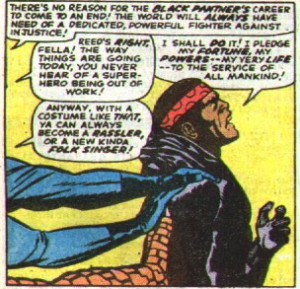 –So we finally have a non-white superhero. This was a huge step for comic books at the time. The Black Panther isn’t merely Marvel’s first black superhero—he’s the first, period. Not the first African-American—he’s the king of a fictitious African nation of Wakanda, which appears primitive on the surface but actually possesses incredibly advanced technology and wealth.
–So we finally have a non-white superhero. This was a huge step for comic books at the time. The Black Panther isn’t merely Marvel’s first black superhero—he’s the first, period. Not the first African-American—he’s the king of a fictitious African nation of Wakanda, which appears primitive on the surface but actually possesses incredibly advanced technology and wealth.
In his first appearance, he invites the Fantastic Four to Wakanda…and promptly proceeds to hunt them. Using a combination of skill and technology, he nearly defeats the FF (and would have, if not for help from the Human Torch’s resourceful college friend Wyatt Wingfoot). And he does so to test his own prowess as he prepares for an impending threat.
His introductory story isn’t all that strong, especially as it comes right after a string of top-notch 1960s FF, but it succeeds in showing the potential of the character—and in showing that a black superhero can be powerful, highly intelligent, and dignified.
To put things in perspective, at the time these issues came out, not all American schools were fully desegregated yet.
The racial diversity also develops with the introduction of Bill Foster, a black scientist, in The Avengers. He’s not a superhero yet, but his day will come. Technically, then, he could qualify as Marvel’s earliest African-American superhero character (the first who would eventually go on to become a superhero, anyway).
–The sexism is rampant as ever, though:
The Wasp in Avengers #34: “If only I understood these things…like a man!” Ugh.
Trending Then
–Hero fights! The Black Panther fights the FF. Iron Man battles the Sub-Mariner. The Thing lashes out against the Silver Surfer.
Maybe that’s why Marvel has underdeveloped villains. The good guys can just fight each other.
Highlights
This wasn’t an especially strong batch of issues, but the best of the bunch is Thor #136-139, in which a race of trolls wage war against Asgard. It’s not great, but it has some excitement within. And it earns bonus points for giving us Sif and getting the whimpering Jane Foster out of the picture in #136.
Avengers #34-35: Stan Lee’s last issue and Roy Thomas’s first as writer are the two weakest issues of the series thus far in this read-through. In this two-parter, new villain the Living Laser falls in love with the Wasp at first sight. Hijinks ensue. “The ways of women are a mystery to me! But, not so my newly developed laser cannon!” It does have its comedic value, though. Like this brilliant exchange from #34:
“Hank! If I didn’t know better, I’d think he’s using a laser ray!” –Bill Foster
“No! There can’t be any doubt! It is a deadly laser!” –Hank Pym
Pym thought bubble: “If that is a laser beam he’s using—we’re up against the deadliest menace imaginable!”
Yes, Pym, the guy who shoots lasers is so much deadlier than that Galactus fellow who was trying to eat the whole planet last month…or any of the evil Asgardian gods like Loki…or time-travelers with advanced weaponry like Kang…or….
The Quotable Marvel
“You’re not wearing a moustache…and you’ve got wavy hair…so you must be a good guy!” –Goliath (Hank Pym), judging people by their looks in Avengers #30.
“That’s the courage of a free country—any man has a chance to sway us—any man may be heard! And, it’s also our strength—it’s the creed by which we live!” –wise, if preachy, words from Captain America in Avengers #33.
“He almost fought the Tumbler to a standstill before…so he’s gotta be someone to reckon with!” –Hawkeye, in Tales of Suspense #84, because we all know the Tumbler is…wait, who?
“Oh, dear! Can this be one of those avant-garde New York happenings I sometimes read about?” –an old lady asks in Thor #131 as an alien carts an unconscious Thor along in a floating clear case.
“The Mole Man! I’ve fought him once before—with the original Avengers! But, I never thought he would dare attack mankind again!” –Tony Stark, genius, in Tales of Suspense #88.
To Be Continued…
We’ll take a little break to complete the very important task of ranking the Marvel Cinematic Universe, and then we’ll pick up right where we left off.

